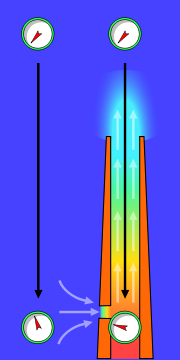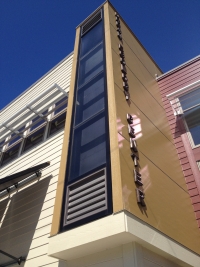Hot air rises because it is less dense than cooler air. In turn, cooler air seeks to fill the vacuum caused by the rising air. Our thermal chimney harnesses this current, pushes it through our exhaust system, and helps to cool the building.

Sunlight is the fuel that keeps all that air moving. As cool air enters the stack through the lower louver (a fancy name for vent) it is heated by sunlight passing through the stack’s south-facing window. The stack’s inner lining is painted black to absorb as much of the Sun’s energy as possible. This movement of air across a heated surface generates what we call a passive heat exchange. So named because, other than sunlight, there is no energy being actively introduced to heat the air inside.
During the summer, the stack’s upper louver closes to prevent a buildup of hot air. This seemed pretty counterintuitive until I spoke with Troy Wohlt – a designer with Uihlein/Wilson Architects. He reminded me that it would be a waste of energy to heat air that is already warm. By closing the top louver we can eliminate the movement of hot air out of the stack and prevent a convective current from forming. That's when we turn to on an even older system for cooling the building - just open a few windows!
Different Versions, One Goal
The design of our thermal stack was the result of a collaborative effort between Uihlein/Wilson Architects and a number of MIAD (Milwaukee Institute of Art & Design) and UW-Milwaukee students. Charged with the task of making the greenest building possible, our team of designers went through several iterations of the solar stacking concept. One model, which would've eliminated an exhaust fan, required construction of a five-story tower in order to be effective!
Whether you're looking at a modern high-rise apartment or the tipi at our Riverside Park branch, it's important to remember that convection and the stack effect are always at play. Here are a few ways you can use these principles at home to reduce your energy consumption:
- Check the insulation in your attic! If your home tends to develop a lot of icicles in the Winter you probably have a leak that is allowing heat to escape through the roof. It’s practically and invitation for cold air!
- Open more windows. During warm summer nights outside air can provide a rapid cooling effect that will continue on to the next day! Remember, you have to give hot air a way out, so if you live in a two-story home make sure an upstairs window is open as well!
- Plant more greenery! By replacing pavement outside your home with plants or other material that doesn’t retain heat, you can increase the amount of cool air circulating into the building.
For a closer look at our solar stack, and the rest of our green building features, please feel free to visit us at our Menomonee Valley Branch on 37th & Pierce St., just one block north of National Avenue!





